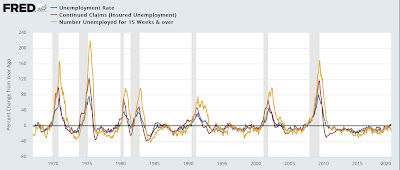- by New Deal democrat
Initial jobless claims declined -3,000 to 217,000 last week. The 4 week average increased 2,000 to 212,750. With a one week delay, continued claims increased 22,000 to 1.834 million:
More importantly for forecasting purposes, YoY both weekly initial claims and their 4 week average were up 4.8%. Continuing claims remained very elevated, up 27.4%:
So far for the month of November, initial claims are up 3.8% YoY, which forecasts that in coming months the unemployment rate may go back down to 3.6%:
In the meantime, since between March and September claims averaged about 11% higher YoY, the unemployment rate could tick higher by another 0.1% to 4.0% - which could be just barely enough to trigger the “Sahm rule” if it averaged 4.0% for 3 months, since it would be 0.5% higher than the 3 month average low in the unemployment rate of 3.5% for December 2022-February 2023:
But I think this is unlikely, since initial claims never quite passed the threshold for signaling recession, which would require a 12.5% or higher YoY comparison for a full 2 months.
Additionally, I wanted to follow up further on the issue of continuing claims and longer term unemployment. This is because several commentators including Cullen Roche have pointed out “when long term unemployment [for 15 weeks or more] rise by 15% or more year over year we are either in a recession or nearing recession 100% of the time.” Here’s his accompanying graph:
But, just as there is a 50+ year reliable history that initial jobless claims lead the unemployment rate, there is a similar leading relationship between continuing claims (red in the graph below) and the number of long term unemployed (gold). And there is also a coincident relationship between continued claims, averaged monthly, and the unemployment rate (blue):
Here’s the post-pandemic update of that graph:
Although continued claims are very elevated YoY, they have plateaued for the past 4 months. That suggests that the unemployment rate is already at or near its short term high (because it is coincident to continuing claims) and also forecasts that long term unemployment will not significantly worsen, unlike the past episodes Roche highlights, in which continuing claims continued to worsen YoY, as shown above.






